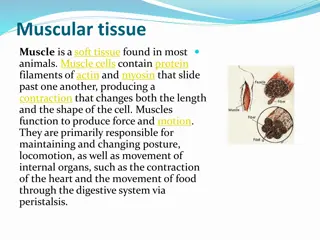Understanding Motor Proteins and Cytoskeletal Dynamics in Cell Biology
Motor proteins, such as myosin, kinesin, and dynein, utilize chemical energy to move along cellular tracks, influencing processes like muscle contraction, organelle movements, and cellular migration. With the ability to translocate using ATP hydrolysis, these proteins play crucial roles in various c
5 views • 14 slides
Understanding Muscle Contraction: Sliding Filament Theory and Cross Bridge Cycle
Explore the fascinating process of muscle contraction through the sliding filament theory and cross bridge cycle. Developed by scientists in 1954, this mechanism involves the interaction between myosin and actin filaments, regulated by calcium and ATP. The cycle includes steps such as myosin binding
0 views • 11 slides
Establishing Plant Cell Division Plane: Key Mechanisms Unveiled
Plants exhibit a unique cell division process essential for growth and development. This process involves intricate control over the positioning of a new cell wall, crucial for proper patterning. Symmetrical and asymmetrical divisions play distinct roles in plant body formation, each regulated by sp
0 views • 9 slides
Understanding Muscle Tissue: Structure and Function
Muscle tissue is a vital component in most animals, facilitating movement and maintaining posture. Derived from embryonic cells, muscles come in three types: skeletal, cardiac, and smooth, each serving specific functions in the body. While skeletal muscles are under voluntary control, cardiac and sm
0 views • 15 slides



